Despite major league improvements in earnings during 2010, analysts fear Daimler AG’s turnaround is looking ragged around the edges. Analysts fear the company’s newly-announced earnings before interest and taxes fell well short of expectations and Daimler’s ability to control its costs is growing suspect.
Dieter Zetsche, chairman of Daimler’s management board, said part of the reason for the poor shape of the so-called EBIT number was the big increase in spending on research and development.
Part of the reason for the rather dramatic rise in research and development spending is Daimler desire to maintain a strong position. And a big part of that has to do with maintaining a strong presence in the Chinese market – which means honoring the Chinese government’s desire for electric-powered vehicles.
Up until recently, Mercedes-Benz has consistently turned up its nose at EVs and countered that it was a leader in diesel technology. Not surprisingly it’s also been something of a laggard in battery technology.
Daimler’s management, however, has undergone a conversion on the road to Beijing and is now scrambling to catch up to mollify China’s gatekeepers.
The price tag, though, is bound to increase dramatically in the near future. And adding to the R&D budget pressures is the need to retool the long-struggling Smart car brand. (Daimler moves to take the Smart brand’s U.S. franchise away from Penske Automotive. Click Here for details.)
Daimler also faces other challenges. It estimates that it is facing a billion dollar rise as the cost of raw materials surges this year. Daimler executives said, however, that their plan to trim costs and raise efficiency should offset the rising material costs.
Almost in the same breath, however, Zetsche also promised to pay shareholders a dividend for the first time in three years and distribute bonus checks to employees.
Analysts looking at the company’s financial statement were quick to note that Daimler’s cash flow in the fourth-quarter of roughly 100 million Euros or about $136 million, wasn’t all that impressive considering what the company claimed as EBIT.
The demand for more research and development money and higher material costs also bring the spotlight back to one of Daimler’s major strategic weaknesses.
Mercedes-Benz has a big name but it sold only 1.9 million vehicles in total around the world, which means it is smaller than Suzuki and Fiat. Only 10 global automakers account for over 77% of production worldwide, according to WorldStreetFundamentals, of Hong Kong.
Zetsche’s predecessor, Juergen Schrempp, tried to hedge against Daimler’s inherent vulnerability by buying Chrysler. Unfortunately, he bought at the top of a bubble in automotive assets and efforts to integrate the two companies failed miserably, largely because the Mercedes-Benz unit at the heart of Daimler wanted no part of the deal.
The irony is Daimler still could use a partner with which to get some added purchasing leverage and share development costs. The German maker has been exploring more limited partnerships, notably with the Renault-Nissan Alliance – the French arm of which will develop some future Smart offerings – and the California battery-car start-up Tesla Motors, which will help with some Daimler EV programs.
Despite the criticism, Zetsche insists Daimler’s 2010 numbers were impressive. “Daimler managed an excellent comeback last year,” he stated, adding that, “Our goal now is to maintain the level we have reached over the long term and to further improve it wherever possible.”
For the record, net profit totaled $6.3 billion in 2010 after a net loss of $3.5 billion in 2009. Revenues increased by 24% and cash flow doubled even with seemingly unfavorable figures in the fourth quarter.

